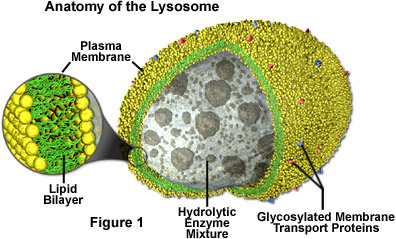How Does a Lysosome Recycle Materials in a Cell
Lysosome A major structure within cells that is surrounded by a membrane. It breaks down large molecules into usable parts.

Lysosome The Cell S Recycling Center Definition Structure Function And Biology
The cells of both plants and animals have many different organelles.

. These cells destroy bacteria dead cells cancerous cells and foreign matter through cell digestion. Their normal function in a healthy cell is to degrade extracellular macromolecules other cells or parts of the cell that are being recycled. Lysosomes are organelles within the cell that prevent the accumulation of malfunctioning proteins by continuously breaking them down into their constituent amino acids which are in turn used to build new proteins.
Lysosomes in human cells recycle amino acid building blocks by capturing and breaking down malfunctioning proteins. Lysosomes have powerful enzymes and acids to digest and recycle cell materials. Microbe Short for microorganism.
Lysosomes break down cellular waste products fats carbohydrates proteins and other macromolecules into simple compounds which are then transferred back into the cytoplasm as new cell-building materialsNov 13 2015 Does lysosome recycle. Some cells such as white blood cells have many more lysosomes than others. The hydrogen ions maintain the.
Jun 8 2018. A mechanism for intralysosomal membrane recycling is proposed. 2 See answers Advertisement Answer 50 5 20 DXGabrielXD It breaks down large molecules into usable parts.
So that means that it has to be protected from the rest of the inside of the cell. Its a compartment then that has a membrane around it that stores the digestive enzymes that. In this regard the lysosomes recycle the cells organic material in a process known as autophagy.
Lysosomes contain many enzymes capable of degrading most of a cells machinery called proteases. When a gene is expressed to regulate the lysis of a lysosome membrane or through other. Cell self-eating and autophagy In the previous section we mention lysosomes can recycle unwanted old cell parts.
Material from outside the cell is taken up in clathrin-coated endocytic vesicles which bud from the plasma membraneand then fuse with early endosomes. It sends excess materials out of the cell. Answered How does a lysosome recycle materials in a cell.
As stated before lysosomes work as the waste discarding structures of the cell by processing undesirable materials and degrading them both from the exterior of the cell and waste constituents inside the cell. Lysosomes break down cellular waste products fats. The lysosome accomplishes this by using chemical reactions with proton pumps on its surface and inside the membrane to transfer hydrogen ions or protons across the membrane and into the interior.
A lysosome is an organelle containing digestive enzymes which it uses to function as the digestion and waste removal for cells food particles bacteria etc. They are active in recycling the cells organic material and in the intracellular digestion of macromolecules. However how does the cell decide what should be recycled in the lysosomes.
It digests cell membranes that are in the way. A living thing that is too small to see with. Judith Stoffer Cellular Stomach Proteins arent the.
The main function of these microscopic organelles is to serve as digestion compartments for cellular materials that have exceeded their lifetime or are otherwise no longer useful. Their function is to break down cellular waste materials. In this regard the lysosomes recycle the cells organic material in a process known as autophagy.
What contains powerful chemicals that break down harmful. Lysosomes are organelles found in the cell that contain acid hydrolase enzymes. In step two a lysosome with an active hydrolytic enzyme comes into the picture as the food vacuole moves away from the plasma membrane.
But sometimes the digestive enzymes may end up damaging the lysosomes themselves and this can cause the cell to die. There are 3 ways in which the lysosome can intake and break down products within the cell. Lysosomes act as the garbage disposal of a cell.
The function of lysosomes is to remove waste as well as destroying a cell after it has died called autolysis. Its interior liquid is acidic and contains enzymes that can be used to break down digest proteins and other types of molecular trash materials for which the cell no longer has any need. It stores large molecules for later use.
It is suggested that membrane can bleb out from these internal vesicles probably in the form of very small vesicles and return to the external lysosomal membrane by membrane fusion. 1 Material internalized by fluid-based pinocytosis and receptor-mediated endocytosis binds to a receptor on the cell surface and then forms a vesicle from the cell membrane of a cell. Lysosomes digest materials taken into the cell and recycle intracellular materials.
Step one shows material entering a food vacuole through the plasma membrane a process known as endocytosis. Membrane components are then recycled to the plasma membrane discussed in detail in Chapter 12 and the early endosomes gradually mature into late endosomes which are the precursors to lysosomes. Now the lysosome is a specific type of organelle thats very acidic.
The lysosome in a cell city project would be the Waste Disposal Plant or Recycle Plant becuase the lysosome digests worn out organells and breaks down organalles that no longer function properly. Amino acids and nucleotides products of lysosomal digestion are recycled back to the cell for the synthesis of new cellular components. Mechanism of Action of Lysosome.
After invagination of the lysosomal membrane during autophagy intralysosomal vesicles are formed.

Molecular Expressions Cell Biology Animal Cell Structure Lysosomes

Lysosome The Cell S Recycling Center Definition Structure Function And Biology

What Does The Lysosome Do In A Animal Cell Biology Brain

Lysosome The Cell S Recycling Center Definition Structure Function And Biology
No comments for "How Does a Lysosome Recycle Materials in a Cell"
Post a Comment